The entire E-Course and E-Module catalog of The Nielsen Environmental E-School is now available for downloading and sharing!
E-Courses and E-Modules Now Available:
The Environmental Sampling E-Course
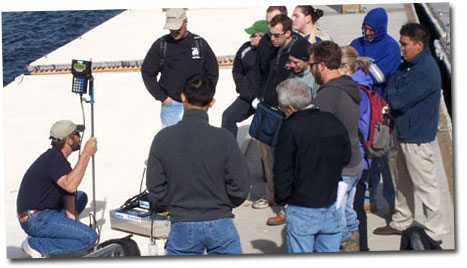 For a detailed description of this E-Course, click here.
For a detailed description of this E-Course, click here.
E-Modules are listed under specific topics covered in the E-Course. You may take the entire package of 32 E-Modules listed below, OR you may take any of the individual modules separately. For a detailed description and outline for the individual E-Modules listed under a topic, click on the topic.
Topic: Planning an Effective Environmental Sampling Program – The Sampling & Analysis Plan
- Module ES–01 -- Planning an Effective Environmental Sampling Program – The Sampling & Analysis Plan
Topic: Developing an Effective Environmental Sampling Strategy
- Module ES–02 -- Developing a Conceptual Site Model and Fine-Tuning it With Site Reconnaissance
- Module ES–03 -- Strategies for Three-Dimensional Sampling of Environmental Media
Topic: Field Equipment Decontamination Procedures for Multi-Media Environmental Sampling
- Module ES–04 -- Field Equipment Decontamination Procedures for Multi-Media Environmental Sampling
Topic: Field Quality Assurance/Quality Control Practices for Multi-Media Environmental Sampling
- Module ES–05 -- Field Quality Assurance/Quality Control Practices for Multi-Media Environmental Sampling
Topic: Environmental Sample Handling and Shipment
- Module ES–06 -- Environmental Sample Handling and Shipment
Topic: Documentation of Environmental Sampling Events
- Module ES–07 -- Documentation of Environmental Sampling Events
Topic: The Science Behind Soil Sampling
- Module ES–08 -- The Science Behind Soil Sampling – Part 1
- Module ES–09 -- The Science Behind Soil Sampling – Part 2
- Module ES–10 -- The Science Behind Soil Sampling – Part 3
Topic: Selection and Use of Soil Sampling Equipment
- Module ES–11 -- Selection and Use of Soil Sampling Equipment – Part 1
- Module ES–12 -- Selection and Use of Soil Sampling Equipment – Part 2
Topic: Soil Sample Handling and Processing Using U.S. EPA Method 5035B
- Module ES–13 -- Soil Sample Handling and Processing Using U.S. EPA Method 5035B – Introduction; Use of Volumetric Sample Collection Methods
- Module ES–14 -- Soil Sample Handling and Processing Using U.S. EPA Method 5035B – Use of Chemical Preservation/Extraction Methods
Topic: Field Sample Analysis Options for Soil Samples
- Module ES–15 -- Field Sample Analysis Options for Soil Samples
Topic: Soil Sample Collection, Description & Handling in the Field
- Module ES-16 -- Soil Sample Collection, Description & Handling in the Field -- Planning and Preparation for Soil Sample Collection and Description; Describing Soil Samples in the Field (Part 1)
- Module ES-17 -- Soil Sample Collection, Description & Handling in the Field -- Describing Soil Samples in the Field (Part 2); Handling Soil Samples in the Field
Topic: The Science Behind Ground-Water Sampling
- Module ES-18 -- The Science Behind Ground-Water Sampling (Part 1): Defining Sampling Objectives; Accuracy, Precision & Bias; Uses of Water-Level Data; Water-Level Measurement Methods; Sources of Bias and Error in Water-Level Measurement
- Module ES-19 -- The Science Behind Ground-Water Sampling (Part 2): Sources of Bias and Error in Ground-Water Sampling; Factors Affecting the Representative Nature of Ground-Water Samples
Topic: Selection and Operation of Ground-Water Purging & Sampling Devices
- Module ES-20 -- Selection and Operation of Ground-Water Purging & Sampling Devices (Part 1) -- Sampling Device Selection Criteria; Sampling Device Impacts on Sample Chemistry; Operational Characteristics and Limitations of Grab Samplers, Suction-Lift Pumps & Electric Centrifugal Submersible Pumps
- Module ES–21 -- Selection and Operation of Ground-Water Purging & Sampling Devices (Part 2) -- Operational Characteristics and Limitations of Positive Displacement Pumps (Gear-Drive Electric Submersible Pumps, Double-Acting Piston Pumps, Gas-Drive Pumps and Bladder Pumps) and Inertial-Lift Devices
Topic: Conventional Purging and Sampling Practices
- Module ES–22 -- Conventional Purging and Sampling Practices for High-Yield and Low-Yield Wells – Well-Volume Purging; Purging to Stabilization of Water-Quality Indicators; Purging to Dryness, Then Sampling
Topic: Low-Flow Purging and Sampling and No-Purge Sampling
- Module ES–23 -- Practices and Procedures for Low-Flow Purging and Sampling
- Module ES–24 -- Practices and Procedures for No-Purge Sampling
Topic: Field Parameter Measurement During Well Purging
- Module ES–25 -- Field Water-Quality Indicator Parameter Measurement During Well Purging
Topic: Ground-Water Sample Pretreatment – Filtration and Preservation
- Module ES–26 -- Ground-Water Sample Filtration
- Module ES–27 -- Ground-Water Sample Preservation
Topic: Overview of Aquatic Systems and Sampling Strategies and Devices for Surface Water
- Module ES–28 -- Overview of Aquatic Systems and Sampling Strategies for Surface Water
- Module ES–29 -- Overview of Surface-Water Sampling Devices
Topic: Overview of Sampling Strategies and Sampling Devices for Sediment
- Module ES-30 -- Overview of Sampling Strategies and Sampling Devices for Sediment
Topic: Waste Sampling Strategies and Methods
- Module ES-31 -- Waste Sampling Strategies and Methods -- Planning a Waste Sampling Program; Sampling Strategies and Devices for Drums, Tanks and Other Containers
- Module ES-32 -- Waste Sampling Strategies and Methods -- Sampling Strategies and Devices for Dumps and Landfills; Stockpiles and Waste Piles; Lagoons, Basins and Pits; Artifactual Sampling
The Complete Ground-Water Monitoring E-Course
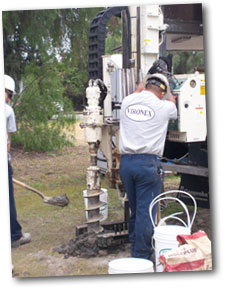 For a detailed description of this E-Course, click here.
For a detailed description of this E-Course, click here.
E-Modules are listed under specific topics covered in the E-Course. You may take the entire package of 29 E-Modules listed below, OR you may take any of the individual E-Modules separately. For a detailed description and outline for the individual E-Modules listed under a topic, click on the topic.
Topic: Optimizing Monitoring Well Placement
- Module GWM-01 - Ground-Water Monitoring Program and Monitoring System Design Elements; Establishing Monitoring Program and Monitoring System Objectives, Data Needs and Uses
- Module GWM-02 - Assembling and Evaluating Important Existing Information (Part 1); Types and Sources of Existing Information
- Module GWM-03 - Assembling and Evaluating Important Existing Information (Part 2); Using Existing Information to Prepare an Initial Conceptual Site Model
- Module GWM-04 - Conducting a Detailed 3-Dimensional Environmental Site Characterization Program – Approaches, Tools and Methods
- Module GWM-05 - Refining the Conceptual Site Model; Selecting Optimum Monitoring Point Locations in 3 Dimensions
Topic: Environmental Drilling Technology for Site Characterization and Monitoring Well Installation
- Module GWM-06 - Factors to Consider in Selecting a Drilling Method; Descriptions, Applications and Limitations of Casing Advancement Drilling Methods
- Module GWM-07 - Descriptions, Applications and Limitations of Fluid Circulation Drilling Methods and Hollow-Stem Augers
Topic: Soil Sample Collection, Description and Handling in the Field
- Module GWM-08 - Planning and Preparation for Soil Sample Collection and Description; Describing Soil Samples in the Field (Part 1)
- Module GWM-09 - Describing Soil Samples in the Field (Part 2); Handling Soil Samples in the Field
Topic: Ground-Water Monitoring Well Design and Construction
- Module GWM-10 - Objectives and Purposes of Monitoring Wells; Sources of Chemical Interference in Well Construction; Selection of Well Casing and Screen Materials; Methods for Joining Well Casing and Screen
- Module GWM-11 - Optimizing Well Diameter; Types and Designs of Well Screens; Selecting Filter-Pack Material Size and Well Screen Slot Size; Optimizing Well Screen Length; Options for Monitoring Multiple Target Monitoring Zones
- Module GWM-12 - Selection and Installation of Filter-Pack Material Type; Selection and Installation of Effective Annular Seal Materials
- Module GWM-13 - Surface Protection for Monitoring Wells; Alternate Well Completions; Direct-Push Well Installation
Topic: Ground-Water Monitoring Well Development
- Module GWM-14 - Ground-Water Monitoring Well Development – Objectives, Applications, Methods and Procedures
Topic: Planning and Executing a Successful Ground-Water Sampling Event
- Module GWM-15 - Planning and Executing a Successful Ground-Water Sampling Event
Topic: Field Equipment Decontamination Procedures
- Module GWM-16 - Field Decontamination Procedures for Ground-Water Sampling Equipment
Topic: Field Quality Assurance/Quality Control Practices
- Module GWM-17 – Field Quality Assurance/Quality Control Practices for Ground-Water Sampling Events
Topic: The Science Behind Ground-Water Sampling
- Module GWM-18 - The Science Behind Ground-Water Sampling (Part 1): Objectives of Ground-Water Sampling; The Importance of High-Quality Data; Uses of Water-Level Data; Water-Level Measurement Methods and Procedures; Recognizing and Avoiding Sources of Bias and Error in Water-Level Measurement
- Module GWM-19 - The Science Behind Ground-Water Sampling (Part 2): Sources of Bias and Error in Ground-Water Sampling; Conditions Under Which Ground Water Occurs; Factors Affecting the Representative Nature of Ground-Water Samples
Topic: Selection and Operation of Ground-Water Purging and Sampling Devices
- Module GWM-20 - Purging and Sampling Device Selection Criteria; Operational Characteristics, Applications and Limitations of Grab Samplers, Suction-Lift Pumps and Electric Centrifugal Submersible Pumps
- Module GWM-21 - Operational Characteristics, Applications and Limitations of Positive Displacement Pumps (Gear-Drive Electric Submersible Pumps, Double-Acting Piston Pumps, Bladder Pumps and Gas-Drive Pumps) and Inertial-Lift Pumps
Topic: Conventional Purging and Sampling Practices
- Module GWM-22 - Conventional Purging and Sampling Practices for High-Yield and Low-Yield Wells
Topic: Low-Flow Purging and Sampling and No-Purge Sampling
- Module GWM-23 - Practices and Procedures for Low-Flow Purging and Sampling
- Module GWM-24 - Practices and Procedures for No-Purge Sampling
Topic: Field-Parameter Measurement During Well Purging
- Module GWM-25 - Field Water-Quality Indicator Parameter Measurement During Well Purging
Topic: Ground-Water Sample Pretreatment: Filtration and Preservation
- Module GWM-26 - Ground-Water Sample Filtration
- Module GWM-27 - Ground-Water Sample Preservation
Topic: Ground-Water Sample Handling and Shipment
- Module GWM-28 – Ground-Water Sample Handling and Shipment
Topic: Sampling Event Documentation
- Module GWM-29 - Documentation of Ground-Water Sampling Events
The Ground-Water Monitoring Well Design, Construction & Development E-Course
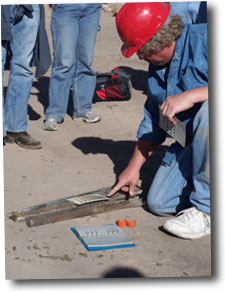 For a detailed description of this E-Course, click here.
For a detailed description of this E-Course, click here.
E-Modules are listed under specific topics covered in the E-Course. You may take the entire package of 14 E-Modules listed below, OR you may take any of the individual E-Modules separately. For a detailed description and outline for the individual E-Modules listed under a topic, click on the topic.
Topic: Optimizing Monitoring Well Placement
- Module GWM-01 - Ground-Water Monitoring Program and Monitoring System Design Elements; Establishing Monitoring Program and Monitoring System Objectives, Data Needs and Uses
- Module GWM-02 - Assembling and Evaluating Important Existing Information (Part 1); Types and Sources of Existing Information
- Module GWM-03 - Assembling and Evaluating Important Existing Information (Part 2); Using Existing Information to Prepare an Initial Conceptual Site Model
- Module GWM-04 - Conducting a Detailed 3-Dimensional Environmental Site Characterization Program – Approaches, Tools and Methods
- Module GWM-05 - Refining the Conceptual Site Model; Selecting Optimum Monitoring Point Locations in 3 Dimensions
Topic: Environmental Drilling Technology for Site Characterization and Monitoring Well Installation
- Module GWM-06 - Factors to Consider in Selecting a Drilling Method; Descriptions, Applications and Limitations of Casing Advancement Drilling Methods
- Module GWM-07 - Descriptions, Applications and Limitations of Fluid Circulation Drilling Methods and Hollow-Stem Augers
Topic: Soil Sample Collection, Description and Handling in the Field
- Module GWM-08 - Planning and Preparation for Soil Sample Collection and Description; Describing Soil Samples in the Field (Part 1)
- Module GWM-09 - Describing Soil Samples in the Field (Part 2); Handling Soil Samples in the Field
Topic: Ground-Water Monitoring Well Design and Construction
- Module GWM-10 - Objectives and Purposes of Monitoring Wells; Sources of Chemical Interference in Well Construction; Selection of Well Casing and Screen Materials; Methods for Joining Well Casing and Screen
- Module GWM-11 - Optimizing Well Diameter; Types and Designs of Well Screens; Selecting Filter-Pack Material Size and Well Screen Slot Size; Optimizing Well Screen Length; Options for Monitoring Multiple Target Monitoring Zones
- Module GWM-12 - Selection and Installation of Filter-Pack Material Type; Selection and Installation of Effective Annular Seal Materials
- Module GWM-13 - Surface Protection for Monitoring Wells; Alternate Well Completions; Direct-Push Well Installation
Topic: Ground-Water Monitoring Well Development
- Module GWM-14 - Ground-Water Monitoring Well Development – Objectives, Applications, Methods and Procedures
The Complete Ground-Water Sampling E-Course
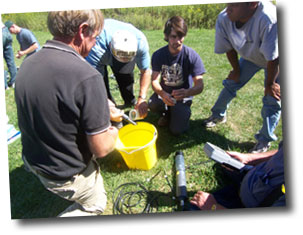 For a detailed description of this E-Course, click here.
For a detailed description of this E-Course, click here.
E-Modules are listed under specific topics covered in the E-Course. You may take the entire package of 15 E-Modules listed below, OR you may take any of the individual E-Modules separately. For a detailed description and outline for the individual E-Modules listed under a topic, click on the topic.
Topic: Planning and Executing a Successful Ground-Water Sampling Event
- Module GWM-15 - Planning and Executing a Successful Ground-Water Sampling Event
Topic: Field Equipment Decontamination Procedures
- Module GWM-16 - Field Decontamination Procedures for Ground-Water Sampling Equipment
Topic: Field Quality Assurance/Quality Control Practices
- Module GWM-17 – Field Quality Assurance/Quality Control Practices for Ground-Water Sampling Events
Topic: The Science Behind Ground-Water Sampling
- Module GWM-18 - The Science Behind Ground-Water Sampling (Part 1): Objectives of Ground-Water Sampling; The Importance of High-Quality Data; Uses of Water-Level Data; Water-Level Measurement Methods and Procedures; Recognizing and Avoiding Sources of Bias and Error in Water-Level Measurement
- Module GWM-19 - The Science Behind Ground-Water Sampling (Part 2): Sources of Bias and Error in Ground-Water Sampling; Conditions Under Which Ground Water Occurs; Factors Affecting the Representative Nature of Ground-Water Samples
Topic: Selection and Operation of Ground-Water Purging and Sampling Devices
- Module GWM-20 - Purging and Sampling Device Selection Criteria; Operational Characteristics, Applications and Limitations of Grab Samplers, Suction-Lift Pumps and Electric Centrifugal Submersible Pumps
- Module GWM-21 - Operational Characteristics, Applications and Limitations of Positive Displacement Pumps (Gear-Drive Electric Submersible Pumps, Double-Acting Piston Pumps, Bladder Pumps and Gas-Drive Pumps) and Inertial-Lift Pumps
Topic: Conventional Purging and Sampling Practices
- Module GWM-22 - Conventional Purging and Sampling Practices for High-Yield and Low-Yield Wells
Topic: Low-Flow Purging and Sampling and No-Purge Sampling
- Module GWM-23 - Practices and Procedures for Low-Flow Purging and Sampling
- Module GWM-24 - Practices and Procedures for No-Purge Sampling
Topic: Field-Parameter Measurement During Well Purging
- Module GWM-25 - Field Water-Quality Indicator Parameter Measurement During Well Purging
Topic: Ground-Water Sample Pretreatment: Filtration and Preservation
- Module GWM-26 - Ground-Water Sample Filtration
- Module GWM-27 - Ground-Water Sample Preservation
Topic: Ground-Water Sample Handling and Shipment
- Module GWM-28 – Ground-Water Sample Handling and Shipment
Topic: Sampling Event Documentation
- Module GWM-29 – Documentation of Ground-Water Sampling Events
The Low-Flow Purging and Sampling and No-Purge Sampling E-Course
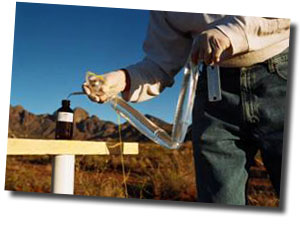 For a detailed description of this E-Course, click here.
For a detailed description of this E-Course, click here.
E-Modules are listed under specific topics covered in the E-Course. You may take the entire package of 13 E-Modules listed below, OR you may take any of the individual E-Modules separately. For a detailed description and outline for the individual E-Modules listed under a topic, click on the topic.
Topic: The Science Behind Ground-Water Sampling
- Module GWM-18 - The Science Behind Ground-Water Sampling (Part 1): Objectives of Ground-Water Sampling; The Importance of High-Quality Data; Uses of Water-Level Data; Water-Level Measurement Methods and Procedures; Recognizing and Avoiding Sources of Bias and Error in Water-Level Measurement
- Module GWM-19 - The Science Behind Ground-Water Sampling (Part 2): Sources of Bias and Error in Ground-Water Sampling; Conditions Under Which Ground Water Occurs; Factors Affecting the Representative Nature of Ground-Water Samples
Topic: Low-Flow Purging and Sampling
- Module GWM-23 - Practices and Procedures for Low-Flow Purging and Sampling
Topic: Selection and Operation of Ground-Water Purging and Sampling Devices
- Module GWM-20 - Purging and Sampling Device Selection Criteria; Operational Characteristics, Applications and Limitations of Grab Samplers, Suction-Lift Pumps and Electric Centrifugal Submersible Pumps
- Module GWM-21 - Operational Characteristics, Applications and Limitations of Positive Displacement Pumps (Gear-Drive Electric Submersible Pumps, Double-Acting Piston Pumps, Bladder Pumps and Gas-Drive Pumps) and Inertial-Lift Pumps
Topic: Field-Parameter Measurement During Well Purging
- Module GWM-25 - Field Water-Quality Indicator Parameter Measurement During Well Purging
Topic: No-Purge Sampling
- Module GWM-24 - Practices and Procedures for No-Purge Sampling
Topic: Field Equipment Decontamination Procedures
- Module GWM-16 - Field Decontamination Procedures for Ground-Water Sampling Equipment
Topic: Field Quality Assurance/Quality Control Practices
- Module GWM-17 – Field Quality Assurance/Quality Control Practices for Ground-Water Sampling Events
Topic: Ground-Water Sample Pretreatment: Filtration and Preservation
- Module GWM-26 - Ground-Water Sample Filtration
- Module GWM-27 - Ground-Water Sample Preservation
Topic: Ground-Water Sample Handling and Shipment
- Module GWM-28 – Ground-Water Sample Handling and Shipment
Topic: Sampling Event Documentation
- Module GWM-29 – Documentation of Ground-Water Sampling Events
The Complete Soil Sampling E-Course
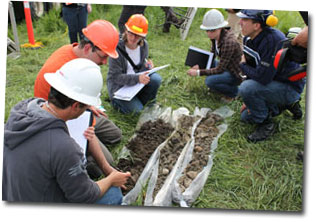 For a detailed description of this E-Course, click here.
For a detailed description of this E-Course, click here.
E-Modules are listed under specific topics covered in the E-Course. You may take the entire package of 17 E-Modules listed below, OR you may take any of the individual E-Modules separately. For a detailed description and outline for the individual E-Modules listed under a topic, click on the topic.
Topic: Planning an Effective Soil Sampling Program – The Sampling & Analysis Plan
- Module SS-01 -- Planning an Effective Soil Sampling Program – The Sampling & Analysis Plan
Topic: Developing an Effective Soil Sampling Strategy
- Module SS-02 -- Developing a Conceptual Site Model and Fine-Tuning it With Site Reconnaissance
- Module ES-03 -- Strategies for Three-Dimensional Sampling of Soil
Topic: Field Equipment Decontamination Procedures for Soil Sampling
- Module SS-04 -- Field Equipment Decontamination Procedures for Soil Sampling
Topic: Field Quality Assurance/Quality Control Practices for Soil Sampling
- Module SS-05 -- Field Quality Assurance/Quality Control Practices for Soil Sampling
Topic: The Science Behind Soil Sampling
- Module SS-06 -- The Science Behind Soil Sampling – Part 1
- Module SS-07 -- The Science Behind Soil Sampling – Part 2
- Module SS-08 -- The Science Behind Soil Sampling – Part 3
Topic: Selection and Use of Soil Sampling Equipment
- Module SS-09 -- Selection and Use of Soil Sampling Equipment – Part 1
- Module SS-10 -- Selection and Use of Soil Sampling Equipment – Part 2
Topic: Soil Sample Handling and Processing Using U.S. EPA Method 5035B
- Module SS-11 -- Soil Sample Handling and Processing Using U.S. EPA Method 5035B – Introduction; Use of Volumetric Sample Collection Methods
- Module SS-12 -- Soil Sample Handling and Processing Using U.S. EPA Method 5035B – Use of Chemical Preservation/Extraction Methods
Topic: Field Sample Analysis Options for Soil Samples
- Module SS-13 -- Field Sample Analysis Options for Soil Samples
Topic: Soil Sample Collection, Description & Handling in the Field
- Module SS-14 -- Soil Sample Collection, Description & Handling in the Field -- Planning and Preparation for Soil Sample Collection and Description; Describing Soil Samples in the Field (Part 1)
- Module SS-15 -- Soil Sample Collection, Description & Handling in the Field -- Describing Soil Samples in the Field (Part 2); Handling Soil Samples in the Field
Topic: Soil Sample Handling and Shipment
- Module SS-16 -- Soil Sample Handling and Shipment
Topic: Documentation of Environmental Sampling Events
- Module SS-17 -- Documentation of Environmental Sampling Events
The Soil Sampling for Volatile Organic Compounds (VOCs) E-Course
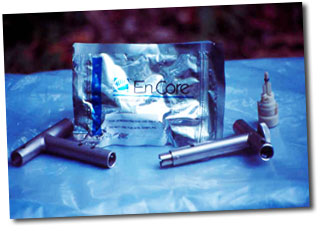 For a detailed description of this E-Course, click here.
For a detailed description of this E-Course, click here.
E-Modules are listed under specific topics covered in the E-Course. You may take the entire package of 14 E-Modules listed below, OR you may take any of the individual E-Modules separately. For a detailed description and outline for the individual E-Modules listed under a topic, click on the topic.
Topic: The Science Behind Soil Sampling
- Module SS-06 -- The Science Behind Soil Sampling – Part 1
- Module SS-07 -- The Science Behind Soil Sampling – Part 2
- Module SS-08 -- The Science Behind Soil Sampling – Part 3
Topic: Selection and Use of Soil Sampling Equipment
- Module SS-09 -- Selection and Use of Soil Sampling Equipment – Part 1
- Module SS-10 -- Selection and Use of Soil Sampling Equipment – Part 2
Topic: Soil Sample Handling and Processing Using U.S. EPA Method 5035B
- Module SS-11 -- Soil Sample Handling and Processing Using U.S. EPA Method 5035B – Introduction; Use of Volumetric Sample Collection Methods
- Module SS-12 -- Soil Sample Handling and Processing Using U.S. EPA Method 5035B – Use of Chemical Preservation/Extraction Methods
Topic: Field Sample Analysis Options for Soil Samples
- Module SS-13 -- Field Sample Analysis Options for Soil Samples
Topic: Field Equipment Decontamination Procedures for Soil Sampling
- Module SS-04 -- Field Equipment Decontamination Procedures for Soil Sampling
Topic: Field Quality Assurance/Quality Control Practices for Soil Sampling
- Module SS-05 -- Field Quality Assurance/Quality Control Practices for Soil Sampling
Topic: Soil Sample Collection, Description & Handling in the Field
- Module SS-14 -- Soil Sample Collection, Description & Handling in the Field -- Planning and Preparation for Soil Sample Collection and Description; Describing Soil Samples in the Field (Part 1)
- Module SS-15 -- Soil Sample Collection, Description & Handling in the Field -- Describing Soil Samples in the Field (Part 2); Handling Soil Samples in the Field
Topic: Soil Sample Handling and Shipment
- Module SS-16 -- Soil Sample Handling and Shipment
Topic: Documentation of Environmental Sampling Events
- Module SS-17 -- Documentation of Environmental Sampling Events


 For a detailed description of this E-Course, click here.
For a detailed description of this E-Course, click here.  For a detailed description of this E-Course, click here.
For a detailed description of this E-Course, click here.  For a detailed description of this E-Course, click here.
For a detailed description of this E-Course, click here. For a detailed description of this E-Course, click here.
For a detailed description of this E-Course, click here. For a detailed description of this E-Course, click here.
For a detailed description of this E-Course, click here. For a detailed description of this E-Course, click here.
For a detailed description of this E-Course, click here.  For a detailed description of this E-Course, click here.
For a detailed description of this E-Course, click here.